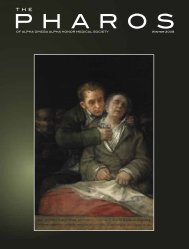Download The Pharos Winter 2011 Edition - Alpha Omega Alpha
Download The Pharos Winter 2011 Edition - Alpha Omega Alpha
Download The Pharos Winter 2011 Edition - Alpha Omega Alpha
Create successful ePaper yourself
Turn your PDF publications into a flip-book with our unique Google optimized e-Paper software.
Reviews and reflections<br />
as Albert Einstein, Thomas Mann, and<br />
Eleanor Roosevelt. After being released<br />
from prison, the young Halsman was<br />
expelled from Austria permanently and<br />
went to Paris, to try fulfill his father’s<br />
dream for him of becoming an engineer<br />
or doctor. After much struggle, Philippe<br />
became a well-known Parisian photographer,<br />
only to flee Paris as the Nazis invaded.<br />
Penniless and stateless, Philippe<br />
emigrated to the United States and rose<br />
to become one of the country’s most<br />
celebrated photographers of the 1950s<br />
and 1960s. His name may be unfamiliar,<br />
but his work we all know: the famous<br />
headshot of Albert Einstein, Marilyn<br />
Monroe in a white dress backed into a<br />
corner, Salvador Dali with the curling<br />
moustache, the Duke and Duchess of<br />
Windsor jumping in the air. Halsman<br />
had more Life magazine covers to his<br />
credit than any photographer in history.<br />
<strong>The</strong> story of <strong>The</strong> Jump Artist is<br />
compelling as an arc from despair to<br />
triumph, but it is not in the straightforward<br />
telling of the story that this strong<br />
debut novel succeeds. Rather, Ratner<br />
writes the inner life of a human being<br />
who has experienced a level of trauma<br />
beyond imagination. His vivid descriptions<br />
of prison, of helplessness, and of<br />
the unearned, but agonizingly felt, guilt<br />
of a victim and survivor are so richly<br />
imagined that the reader feels that he<br />
comes to know the interior Halsman.<br />
We feel his adolescent struggles with<br />
a father whom he loved and venerated<br />
but was irritated by, his haunting sense<br />
of loss, his shocked passivity in the face<br />
of victimization, and his self-loathing,<br />
so common in victims of trauma. As<br />
he tries to make sense of his surreal<br />
experience, he moves to art just as the<br />
surrealist movement is gaining sway in<br />
Europe, and his use of the camera begins<br />
to move him into the outside world.<br />
<strong>The</strong> camera captures the full range of<br />
human emotion, from the surreal to<br />
the playful to the beautiful. As Halsman<br />
slowly allows love and art into his life,<br />
he reclaims his life. Ratner’s use of language<br />
and his strong artistic storytelling<br />
draws the reader deep into Halsman’s<br />
world and, as the novel builds, we root<br />
for his success, hoping he will overcome<br />
the tragedy of his youth. It is not just the<br />
story that stays with you, it is Halsman<br />
the human being.<br />
As physicians we are always struggling<br />
to understand the human condition.<br />
This stunning novel does what all<br />
truly fine novels should do. It illuminates<br />
an understanding of the human<br />
condition through its moving exploration<br />
of trauma, suffering, and redemption.<br />
Dr. Ponsky is the Oliver H. Payne Professor<br />
and chairman of the Department of<br />
Surgery at Case Western Reserve University<br />
and the Surgeon-in-Chief of University<br />
Hospital at Case Medical Center in Cleveland.<br />
His address is:<br />
University Hospitals, Case Medical<br />
Center<br />
Department of Surgery<br />
11100 Euclid Avenue, LKS-5047<br />
Cleveland, Ohio 44106<br />
E-mail: jeffrey.ponsky@uhhospitals.org<br />
Henry Kaplan and the Story of<br />
Hodgkin’s Disease<br />
Charlotte De Croes Jacobs<br />
Stanford, California, Stanford University<br />
Press, 2010<br />
Reviewed by William M. Rogoway,<br />
MD<br />
<strong>The</strong> 1960s and early ’70s were times<br />
of significant change in the approach<br />
to cancer therapy in this country.<br />
As the hazards and potential benefits of<br />
radiation therapy became more widely<br />
appreciated, it became a powerful treatment<br />
tool. At the same time, drugs were<br />
developed that not only led to tumor<br />
shrinkage, but, in the case of childhood<br />
leukemia, could eradicate disease.<br />
Henry Kaplan was a towering figure in<br />
this heady time of oncologic creativity.<br />
Charlotte Jacobs traces Kaplan’s beginnings<br />
in Chicago as the older son<br />
of Russian immigrants, recounting the<br />
early death of his father and his determined<br />
mother’s struggles to keep the<br />
family afloat financially and to further<br />
her favorite child’s ambitious goals. This<br />
story is interwoven with the history of<br />
the gradual recognition of Hodgkin’s<br />
disease as an entity, from Thomas<br />
Hodgkin’s original cases to Dorothy<br />
Reed’s defining pathologic description,<br />
as well as the development of radiation<br />
therapy from a scientific curiosity to a<br />
therapeutic tool. By the time Dr. Kaplan<br />
graduated from Rush Medical College<br />
in 1941, a rudimentary understanding<br />
of the disease with which he became so<br />
identified existed and radiotherapy had<br />
been used as treatment.<br />
Dr. Jacobs outlines Henry Kaplan’s<br />
rapid professional trajectory from<br />
trainee to chairman of Radiology at<br />
Stanford Medical School at age twentynine;<br />
the remainder of the book is devoted<br />
to his diverse and impressive<br />
scientific and personal achievements.<br />
<strong>The</strong> over-riding theme is that of a brilliant<br />
physician driven to ever-more ambitious<br />
goals.<br />
Where does one begin? <strong>The</strong> Stanford<br />
linear accelerator that permitted higher<br />
energy and more targeted x-ray therapy,<br />
the willingness to deliver higher doses<br />
of radiation to wider fields in the quest<br />
for Hodgkin’s disease cure, the identification<br />
of the mouse leukemia virus and<br />
the search for a human viral etiology for<br />
malignancy, attempts to create antibodies<br />
to human tumors. Kaplan gained<br />
48 <strong>The</strong> <strong>Pharos</strong>/<strong>Winter</strong> <strong>2011</strong>














